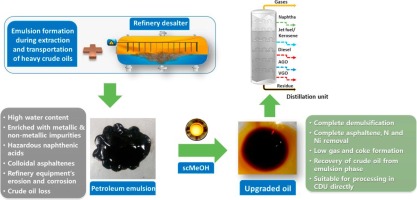Our official English website, www.x-mol.net, welcomes your
feedback! (Note: you will need to create a separate account there.)
Conversion of petroleum emulsion into light fraction-rich upgraded oil in supercritical methanol
Fuel ( IF 6.7 ) Pub Date : 2018-04-01 , DOI: 10.1016/j.fuel.2017.12.122 Muhammad Kashif Khan , Winarto Kwek , Jaehoon Kim
Fuel ( IF 6.7 ) Pub Date : 2018-04-01 , DOI: 10.1016/j.fuel.2017.12.122 Muhammad Kashif Khan , Winarto Kwek , Jaehoon Kim

|
Abstract Unconventional crude oil extraction, transportation, and downstream refining have encountered a huge formation of petroleum emulsion (or rag layer), which causes serious problems such as equipment corrosion, loss of crude oil, and catalyst poisoning. In addition, if not treated properly, the rag layer engenders toxic and hazardous effects on the environment and living organisms. In this study, we developed a supercritical methanol (scMeOH) route to convert the petroleum emulsions into light fraction-rich upgraded oil with low impurities. Several process variables were investigated, including temperature (350–400 °C), rag layer concentration (16.7–100 wt%), and reaction time (30–90 min). At 400 °C, 35 MPa, 16.7 wt%, and 90 min, a high recoverable oil yield (76.7 wt%) was achieved. In addition, the naphtha-to-diesel fractions increased significantly from 6.0 (rag layer) to 42.0 wt% (upgraded oil), the acidity in terms of total acid number (TAN) was reduced by up to 91.5% from 58.7 (rag layer) to 5.0 mg-KOH/g-oil (upgraded oil), and the heteroatoms (O, N, S) and metallic impurities (Ca, Ni, V, Fe) were reduced significantly in the upgraded oil. A model compound study revealed that esterification is the major deacidification pathway for TAN reduction. The rag layer conversion in scMeOH was compared with those in subcritical water (without adding additional methanol or water) and in supercritical water (scH 2 O). Asphaltenes, Ni, and N were completely removed from the toxic rag layer in the presence of scMeOH as compared to scH 2 O treatment, which makes it more suitable for upgrading.
中文翻译:

石油乳液在超临界甲醇中转化为富含轻馏分的改质油
摘要 非常规原油开采、运输和下游炼制过程中,遇到了大量形成的石油乳状液(或碎屑层),造成设备腐蚀、原油流失、催化剂中毒等严重问题。此外,如果处理不当,碎布层会对环境和生物产生有毒有害影响。在这项研究中,我们开发了一种超临界甲醇 (scMeOH) 路线,将石油乳液转化为低杂质、富含轻馏分的升级油。研究了几个过程变量,包括温度 (350–400 °C)、碎屑层浓度 (16.7–100 wt%) 和反应时间 (30–90 分钟)。在 400 °C、35 MPa、16.7 wt% 和 90 min 下,实现了高可采油收率(76.7 wt%)。此外,石脑油与柴油的比例从 6.0(碎屑层)显着增加到 42.0 wt%(升级油),总酸值 (TAN) 的酸度从 58.7(碎屑层)降低到 5.0,高达 91.5% mg-KOH/g-油(升级油)、杂原子(O、N、S)和金属杂质(Ca、Ni、V、Fe)在升级油中显着减少。模型化合物研究表明,酯化是 TAN 减少的主要脱酸途径。将 scMeOH 中的碎屑层转化率与亚临界水(不添加额外的甲醇或水)和超临界水 (scH 2 O) 中的转化率进行比较。与 scH 2 O 处理相比,在 scMeOH 存在下,沥青质、Ni 和 N 从有毒碎布层中完全去除,这使其更适合升级。0 wt%(升级油),总酸值 (TAN) 的酸度从 58.7(碎布层)降低至 91.5% 至 5.0 mg-KOH/g-油(升级油),杂原子( O、N、S)和金属杂质(Ca、Ni、V、Fe)在提质油中显着减少。模型化合物研究表明,酯化是 TAN 减少的主要脱酸途径。将 scMeOH 中的碎屑层转化率与亚临界水(不添加额外的甲醇或水)和超临界水 (scH 2 O) 中的转化率进行比较。与 scH 2 O 处理相比,在 scMeOH 存在下,沥青质、Ni 和 N 从有毒碎布层中完全去除,这使其更适合升级。0 wt%(升级油),总酸值 (TAN) 的酸度从 58.7(碎布层)降低至 91.5% 至 5.0 mg-KOH/g-油(升级油),杂原子( O、N、S)和金属杂质(Ca、Ni、V、Fe)在提质油中显着减少。模型化合物研究表明,酯化是 TAN 减少的主要脱酸途径。将 scMeOH 中的碎屑层转化率与亚临界水(不添加额外的甲醇或水)和超临界水 (scH 2 O) 中的转化率进行比较。与 scH 2 O 处理相比,在 scMeOH 存在下,沥青质、Ni 和 N 从有毒碎布层中完全去除,这使其更适合升级。提质油中杂原子(O、N、S)和金属杂质(Ca、Ni、V、Fe)显着减少。模型化合物研究表明,酯化是 TAN 减少的主要脱酸途径。将 scMeOH 中的碎屑层转化率与亚临界水(不添加额外的甲醇或水)和超临界水 (scH 2 O) 中的转化率进行比较。与 scH 2 O 处理相比,在 scMeOH 存在下,沥青质、Ni 和 N 从有毒碎布层中完全去除,这使其更适合升级。提质油中杂原子(O、N、S)和金属杂质(Ca、Ni、V、Fe)显着减少。模型化合物研究表明,酯化是 TAN 减少的主要脱酸途径。将 scMeOH 中的碎屑层转化率与亚临界水(不添加额外的甲醇或水)和超临界水 (scH 2 O) 中的转化率进行比较。与 scH 2 O 处理相比,在 scMeOH 存在下,沥青质、Ni 和 N 从有毒碎布层中完全去除,这使其更适合升级。将 scMeOH 中的碎屑层转化率与亚临界水(不添加额外的甲醇或水)和超临界水 (scH 2 O) 中的转化率进行比较。与 scH 2 O 处理相比,在 scMeOH 存在下,沥青质、Ni 和 N 从有毒碎布层中完全去除,这使其更适合升级。将 scMeOH 中的碎屑层转化率与亚临界水(不添加额外的甲醇或水)和超临界水 (scH 2 O) 中的转化率进行比较。与 scH 2 O 处理相比,在 scMeOH 存在下,沥青质、Ni 和 N 从有毒碎布层中完全去除,这使其更适合升级。
更新日期:2018-04-01
中文翻译:

石油乳液在超临界甲醇中转化为富含轻馏分的改质油
摘要 非常规原油开采、运输和下游炼制过程中,遇到了大量形成的石油乳状液(或碎屑层),造成设备腐蚀、原油流失、催化剂中毒等严重问题。此外,如果处理不当,碎布层会对环境和生物产生有毒有害影响。在这项研究中,我们开发了一种超临界甲醇 (scMeOH) 路线,将石油乳液转化为低杂质、富含轻馏分的升级油。研究了几个过程变量,包括温度 (350–400 °C)、碎屑层浓度 (16.7–100 wt%) 和反应时间 (30–90 分钟)。在 400 °C、35 MPa、16.7 wt% 和 90 min 下,实现了高可采油收率(76.7 wt%)。此外,石脑油与柴油的比例从 6.0(碎屑层)显着增加到 42.0 wt%(升级油),总酸值 (TAN) 的酸度从 58.7(碎屑层)降低到 5.0,高达 91.5% mg-KOH/g-油(升级油)、杂原子(O、N、S)和金属杂质(Ca、Ni、V、Fe)在升级油中显着减少。模型化合物研究表明,酯化是 TAN 减少的主要脱酸途径。将 scMeOH 中的碎屑层转化率与亚临界水(不添加额外的甲醇或水)和超临界水 (scH 2 O) 中的转化率进行比较。与 scH 2 O 处理相比,在 scMeOH 存在下,沥青质、Ni 和 N 从有毒碎布层中完全去除,这使其更适合升级。0 wt%(升级油),总酸值 (TAN) 的酸度从 58.7(碎布层)降低至 91.5% 至 5.0 mg-KOH/g-油(升级油),杂原子( O、N、S)和金属杂质(Ca、Ni、V、Fe)在提质油中显着减少。模型化合物研究表明,酯化是 TAN 减少的主要脱酸途径。将 scMeOH 中的碎屑层转化率与亚临界水(不添加额外的甲醇或水)和超临界水 (scH 2 O) 中的转化率进行比较。与 scH 2 O 处理相比,在 scMeOH 存在下,沥青质、Ni 和 N 从有毒碎布层中完全去除,这使其更适合升级。0 wt%(升级油),总酸值 (TAN) 的酸度从 58.7(碎布层)降低至 91.5% 至 5.0 mg-KOH/g-油(升级油),杂原子( O、N、S)和金属杂质(Ca、Ni、V、Fe)在提质油中显着减少。模型化合物研究表明,酯化是 TAN 减少的主要脱酸途径。将 scMeOH 中的碎屑层转化率与亚临界水(不添加额外的甲醇或水)和超临界水 (scH 2 O) 中的转化率进行比较。与 scH 2 O 处理相比,在 scMeOH 存在下,沥青质、Ni 和 N 从有毒碎布层中完全去除,这使其更适合升级。提质油中杂原子(O、N、S)和金属杂质(Ca、Ni、V、Fe)显着减少。模型化合物研究表明,酯化是 TAN 减少的主要脱酸途径。将 scMeOH 中的碎屑层转化率与亚临界水(不添加额外的甲醇或水)和超临界水 (scH 2 O) 中的转化率进行比较。与 scH 2 O 处理相比,在 scMeOH 存在下,沥青质、Ni 和 N 从有毒碎布层中完全去除,这使其更适合升级。提质油中杂原子(O、N、S)和金属杂质(Ca、Ni、V、Fe)显着减少。模型化合物研究表明,酯化是 TAN 减少的主要脱酸途径。将 scMeOH 中的碎屑层转化率与亚临界水(不添加额外的甲醇或水)和超临界水 (scH 2 O) 中的转化率进行比较。与 scH 2 O 处理相比,在 scMeOH 存在下,沥青质、Ni 和 N 从有毒碎布层中完全去除,这使其更适合升级。将 scMeOH 中的碎屑层转化率与亚临界水(不添加额外的甲醇或水)和超临界水 (scH 2 O) 中的转化率进行比较。与 scH 2 O 处理相比,在 scMeOH 存在下,沥青质、Ni 和 N 从有毒碎布层中完全去除,这使其更适合升级。将 scMeOH 中的碎屑层转化率与亚临界水(不添加额外的甲醇或水)和超临界水 (scH 2 O) 中的转化率进行比较。与 scH 2 O 处理相比,在 scMeOH 存在下,沥青质、Ni 和 N 从有毒碎布层中完全去除,这使其更适合升级。











































 京公网安备 11010802027423号
京公网安备 11010802027423号